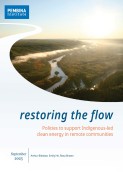On September 25, 2007, at a meeting of the Council of Energy Ministers (CEM) in Whistler, B.C., federal, provincial and territorial energy ministers will be discussing a National Energy Efficiency Action Plan, the first time both levels of government have agreed to work together on this important issue. But will the agreement that the Minister’s produce be a real “plan” and contain the targets, policies and concrete actions needed to transform the way we use energy in Canada?
What would real progress look like?
Ministers meeting in Whistler should make concrete commitments for the coming year – agreeing to report back regularly on progress towards their goals at future CEM meetings. We encourage the following:
- Within 2008 federal, provincial and territorial budgets, commit significant new multi- year financial and staff resources to new energy-efficiency initiatives for each sector of the economy;
- Work together on at least five concrete collaborative actions in 2008 and report on progress at the next CEM meeting;
- Prepare individual federal and provincial energy-efficiency targets and plans in 2008 for consideration at the 2008 CEM meeting;
- Set up and fund a CEM energy-efficiency secretariat to support inter-governmental and stakeholder collaboration, monitor progress and prepare a white paper consolidating targets and plans by September 2008 - or delegate this role to the federal OEE.
How much energy efficiency can we achieve?
Background papers prepared for the ministers by multi-stakeholder working groups show that energy energy use in all sectors of the Canadian economy could be completely transformed through efficiency over the next 20 years:
- All existing buildings and homes could be retrofitted to provide, on average 30% or more savings in heat and electrical energy.
- All new buildings and houses could have net zero energy requirements (annual energy used equal to energy produced on-site annually.).
- Cities, towns and communities could produce most of their own energy through urban design improvements and local energy production.
- Industrial energy intensity (energy use per unit of production) could be improved by up to 4% each year.
- Personal energy use for transport (km per person) could be reduced by one-third and freight energy use reduced by a similar amount.










